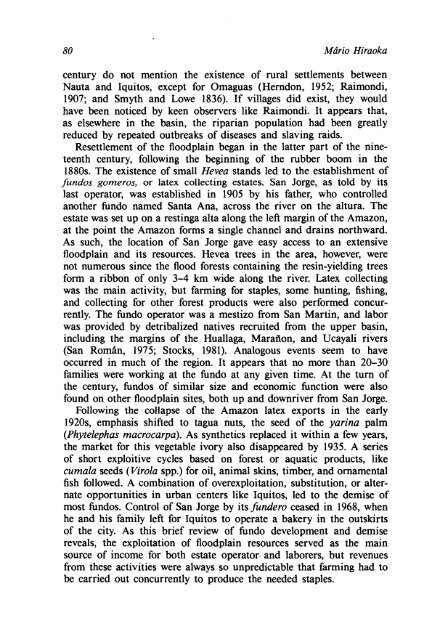Fragile Lands of Latin America Strategies for ... - PART - USAID
Fragile Lands of Latin America Strategies for ... - PART - USAID
Fragile Lands of Latin America Strategies for ... - PART - USAID
Create successful ePaper yourself
Turn your PDF publications into a flip-book with our unique Google optimized e-Paper software.
80 Mdrio Hiraoka<br />
century do not mention the existence <strong>of</strong> rural settlements between<br />
Nauta and Iquitos, except <strong>for</strong> Omaguas (Herndon, 1952; Raimondi,<br />
1907; and Smyth and Lowe 1836). If villages did exist, they would<br />
have been noticed by keen observers like Raimondi. It appears that,<br />
as elsewhere in the basin, the riparian population had been greatly<br />
reduced by repeated outbreaks <strong>of</strong> diseases and slaving raids.<br />
Resettlement <strong>of</strong> the floodplain began in the latter part <strong>of</strong> the nine-<br />
teenth century, following the beginning <strong>of</strong> the rubber boom in the<br />
1880s. The existence <strong>of</strong> small Hevea stands led to the establishment <strong>of</strong><br />
fundos gomeros, or latex collecting estates. San Jorge, as told by its<br />
last operator, was established in 1905 by his father, who controlled<br />
another fundo named Santa Ana, across the river on the altura. The<br />
estate was set up on a restinga alta along the left margin <strong>of</strong> the Amazon,<br />
at the point the Amazon <strong>for</strong>ms a single channel and drains northward.<br />
As such, the location <strong>of</strong> San Jorge gave easy access to an extensive<br />
floodplain and its resources. Hevea trees in the area, however, were<br />
not numerous since the flood <strong>for</strong>ests containing the resin-yielding trees<br />
<strong>for</strong>m a ribbon <strong>of</strong> only 3-4 km wide along the river. Latex collecting<br />
was the main activity, but farming <strong>for</strong> staples, some hunting, fishing,<br />
and collecting <strong>for</strong> other <strong>for</strong>est products were also per<strong>for</strong>med concur-<br />
rently. The fundo operator was a mestizo from San Martin, and labor<br />
was provided by detribalized natives recruited from the upper basin,<br />
including the margins <strong>of</strong> the Huallaga, Marailon, and Ucayali rivers<br />
(San Romiin, 1975; Stocks, 1981). Analogous events seem to have<br />
occurred in much <strong>of</strong> the region. It appears that no more than 20-30<br />
families were working at the fundo at any given time. At the turn <strong>of</strong><br />
the century, fundos <strong>of</strong> similar size and economic function were also<br />
found on other floodplain sites, both up and downriver from San Jorge.<br />
Following the collapse <strong>of</strong> the Amazon latex exports in the early<br />
1920s, emphasis shifted to tagua nuts, the seed <strong>of</strong> the yarina palm<br />
(Phytelephas macrocarpa). As synthetics replaced it within a few years,<br />
the market <strong>for</strong> this vegetable ivory also disappeared by 1935. A series<br />
<strong>of</strong> short exploitive cycles based on <strong>for</strong>est or aquatic products, like<br />
cumala seeds (Virola spp.) <strong>for</strong> oil, animal skins, timber, and ornamental<br />
fish followed. A combination <strong>of</strong> overexploitation, substitution, or alter-<br />
nate opportunities in urban centers like Iquitos, led to the demise <strong>of</strong><br />
most fundos. Control <strong>of</strong> San Jorge by its fundero ceased in 1968, when<br />
he and his family left <strong>for</strong> Iquitos to operate a bakery in the outskirts<br />
<strong>of</strong> the city. As this brief review <strong>of</strong> fundo development and demise<br />
reveals, the exploitation <strong>of</strong> floodplain resources served as the main<br />
source <strong>of</strong> income <strong>for</strong> both estate operator. and laborers, but revenues<br />
from these activities were always so unpredictable that farming had to<br />
be carried out concurrently to produce the needed staples.

















